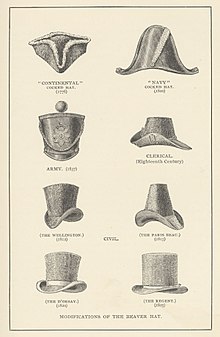

A hat is a head covering which is worn for various reasons, including protection against weather conditions, ceremonial reasons such as university graduation, religious reasons, safety, or as a fashion accessory.[1] Hats which incorporate mechanical features, such as visors, spikes, flaps, braces or beer holders shade into the broader category of headgear.
In the past, hats were an indicator of social status.[2] In the military, hats may denote nationality, branch of service, rank or regiment.[3] Police typically wear distinctive hats such as peaked caps or brimmed hats, such as those worn by the Royal Canadian Mounted Police. Some hats have a protective function. As examples, the hard hat protects construction workers' heads from injury by falling objects, a British police Custodian helmet protects the officer's head, a sun hat shades the face and shoulders from the sun, a cowboy hat protects against sun and rain and an ushanka fur hat with fold-down earflaps keeps the head and ears warm. Some hats are worn for ceremonial purposes, such as the mortarboard, which is worn (or carried) during university graduation ceremonies. Some hats are worn by members of a certain profession, such as the Toque worn by chefs, or the mitre worn by Christian bishops. Adherents of certain religions regularly wear hats, such as the turban worn by Sikhs, or the church hat that is worn as a headcovering by Christian women during prayer and worship.[4]
- ^ Pauline Thomas (2007-09-08). "The Wearing of Hats Fashion History". Fashion-era.com. Retrieved 2011-07-02.
- ^ "The social meanings of hats". University of Chicago Press. Retrieved 2011-07-02.
- ^ "Insignia:The Way You Tell Who's Who in the Military". United States Department of Defense. Archived from the original on 2012-04-14. Retrieved 2011-07-02.
- ^ "What are Church Hats?". Southern Living. Archived from the original on 14 May 2021. Retrieved 10 May 2022.
Church hats have been a key part of churchgoers' Sunday best for years, and are still an important aspect of dress in some churches today. The practice of covering one's head for church originally came from the Bible—1 Corinthians 11:15, to be precise. The simple head covering has been adapted and expanded to become a stylish part of Southern women's churchgoing attire. At the turn of the century, many Southern ladies wore simple hats to church out of respect, reverence for the service, and continuity with passed-down traditions. The church hat tradition continues today, with hats—sometimes called crowns—in bright colors, bold patterns, and eye-catching styles at Sunday services across the South.